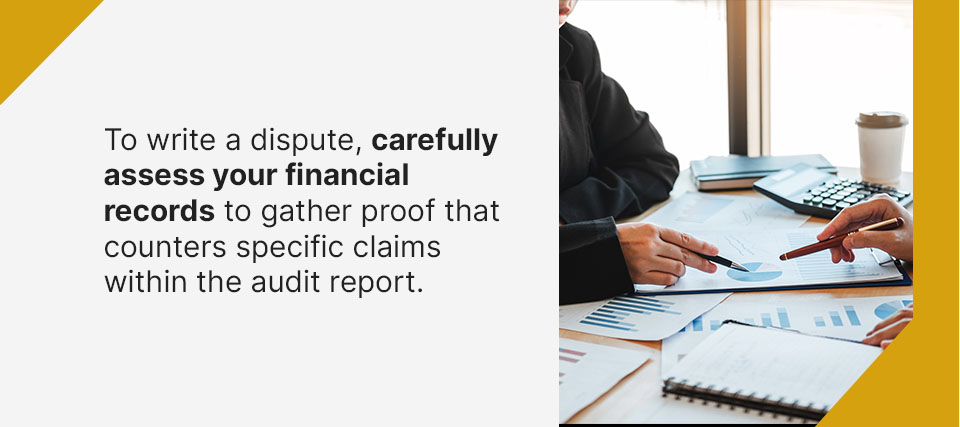What Do I Do With My Audit Report Once Received?

Audit reports are written assessments of whether a company’s financial statements comply with generally accepted accounting principles (GAAP) and are free of incorrect information. Auditors’ findings provide management, shareholders and potential investors with valuable financial information and insights on your business’s financial position.
If you’re new to the auditing process, you may wonder what to do after receiving your audit report. You can take several courses of action, depending on the auditors’ findings and whether you agree with them.
What Happens After You Receive Your Audit Report?
An audit report includes a written letter attached to your company’s financial statements detailing the auditors’ opinions of your GAAP compliance. It states the auditors’ responsibility, the accounting principles that guided the report and the auditors’ opinions.
After you receive your company’s audit report, you can assess the auditors’ findings and determine if you agree or disagree with their assessments. Then, you can gather important documentation and respond to the audit findings.
Read and Analyze the Audit Findings Report
Read through the audit report immediately when it arrives. The report will contain key findings and recommendations that your business will be in a position to recognize or dispute. Auditors will use the report to inform you of any determination around your internal controls’ compliance with GAAP standards. A separate document will contain possible grievances the auditor may have with your internal controls. You will also receive recommendations for improving controls.
By analyzing the report, you can verify its contents and determine if there are any items to dispute. Key decision-makers should read through the report and provide feedback about the auditor’s findings and the methods the auditor used to assess your business.
Compile Necessary Documentation
Gathering relevant documentation is an important next step after reading through the audit report. There are two reasons to gather documentation after the audit, and one or both may apply.
There are many types of financial documentation that aid auditors in their processes. You’ll provide these documents at the start of the process, but the auditor may request more in their report. Gather relevant documents after reading through the auditor’s findings to satisfy their requests.
You will need various financial documents if you disagree with the auditor’s findings. Your business may have proof within its documentation that it meets various GAAP standards. Gather financial statements, compliance verification, expense reports and governance documents to prove your financial information and support your claims.
Deliver a Response
Any audit report your business receives warrants a written response from your management. The contents of your response depend on whether you agree or disagree with the auditor’s findings. If you agree with the findings and recommended solutions, you can respond and confirm this. Otherwise, you can dispute the auditor’s claim.
What to Do If You Agree With the Auditors’ Findings
If you agree with the conclusions of the audit report, your next steps are fairly simple. All audits with recommendations or concerns are subject to a post-audit review to verify that your management addresses the suggestions outlined in the auditor’s report.
To proceed, you’ll state that you agree with the auditors’ findings. You’ll also detail the steps you’ll take to resolve any operational deficiencies identified in the report. The steps you provide should be specific and time-bound. While it takes time to complete your action plan for the audit’s findings, detailing a precise path forward shows your commitment to resolving the auditor’s concerns.
What to Do If You Disagree With the Conclusions on an Audit Report
You can oppose the auditor’s conclusions by stating your disagreement with the audit response and reasoning to back up your statement. The audit report will include sections for each claim where you can provide clarification.

To write a dispute, carefully assess your financial records to gather proof that counters specific claims within the audit report. Write a detailed response that shows how your processes followed the specific regulations, laws or guidelines the auditor claims you broke. Use clear, concise and respectful language within your dispute to show that your business and the auditor share a common interest in proper accounting practices.
Upon receiving your dispute claim, your auditors will respond with further explanation to rebut your assertion. Their response may show a process failure or oversight that helps your case and elicits further investigation.
The decision to dispute an audit is one you should make carefully. Auditors and oversight agencies will give your situation extra scrutiny to determine the validity of your dispute.
Follow All Recommendations
Whether you agree with the auditor’s finding or you come to a mutual understanding through the dispute process, it’s important to implement the final recommendations the auditor provides. Keep note of the specific recommendations your auditor provided and document the processes you use to enact them. The auditor will follow up, so recording your methods will help you prove your adherence.
Submit an Auditor Evaluation
Once your auditor issues a final audit report, management must evaluate the audit’s quality, taking into account the auditor’s communication, performance, professionalism and recommendations. To assess these areas, you can verify that the auditor tested relevant aspects of your business and industry. If you’re unsatisfied with your auditor, you can submit a proposal requesting that you get a new one.
Book Audit and Assurance Services at Marshall Jones
If you require assistance with your next audit, consider audit and assurance services from the Certified Public Accountants and Advisors at Marshall Jones. We conduct our accounting services with humility and integrity in mind.
Contact us to learn more about our services today!
